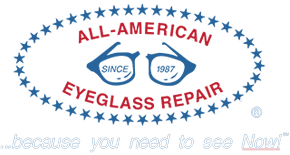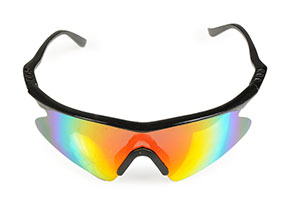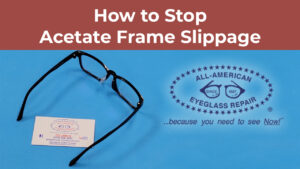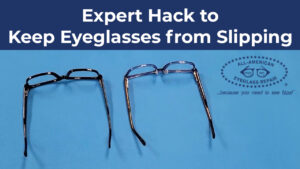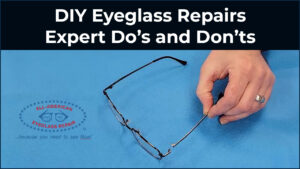Nowadays, parent, players and coaches recognize the harmful injuries that can happen when protective eyewear for sports is not worn in the field. Wearing professional eyewear in sports helps players with their vision while reducing eye injury.
What sports require protective eyewear?
When it comes to eye injuries, most of the trauma happens when an individual is playing a high-risk sport. So, what exactly is a high-risk sport?
Low risk sports are classified as sports that are played without using an object like a stick, puck, ball, racquet or bat. They also usually have no body contact – some examples of a low risk sport include: gymnastics, swimming, track and cycling.
Sports that involve high risk are basketball, hockey, football, baseball, tennis, racquetball, water polo and lacrosse. As you can see, protective eyewear is necessary since all these sports involve body contact. They also use a ball, bat, stick, racquet or puck. At the other end of the spectrum, you have boxing, martial arts, and wrestling and a lot of body contact.
When playing sports, if you’re wondering whether you should wear protective eyewear, you have your answer. Consider if the sport involves the use of an object that can injure your eyes.
Why can’t I just wear my regular glasses?
Think about having a car that only has a regular plastic bag. That plastic bag won’t come into question until an accident happened. In the meantime, you’ll be okay having it in your car. Protective eyewear works in the same way. You may think you can wear your standard eyeglasses until you get into a high impact situation that places your eyes at risk. Normal glasses look like they’re working until you actually need them to work!
Regular glasses have not been created with material that can absorb the impact many sports have. Companies like Liberty Eyewear offer sports eyewear called Rec Specs. Such eyewear is created with certified protection meant for indoor or outdoor play.
You may still be wondering if you really need eyewear that can protect your eyes while playing sports. Imagine a ball flying at high speed in the wrong direction. We can already predict what could happen to the unsuspecting racquetball player. Flying objects may be obvious, but there’s another danger when playing sports. The unseen often happens when someone is poked in the eye, jabbed, elbowed or body checked. Eye injuries can all happen within close body contact.
Looking for the Right Protective Sports Eyewear
Looking for eyewear that offers adequate protection in sports involves a search for various features. So, what exactly are you looking for when you want top-notch eye protection? Here are some features to look for.
Size
There are so many sizes and a lot of shapes and it can be overwhelming to sift through and find a perfect fit. Whether you’re a racquetball player, a basketball player, soccer player or hockey player, there is no reason you can’t find eyewear to protect your eyes. For those sports players who need a helmet can find goggles designed to accommodate a helmet.
The lens
Your standard, daily, lenses are made from a different lens material than a protective eyewear lens. Polycarbonate is the material that makes a lens resist high impact from flying objects. If you’re playing outdoors, you also get the benefit of having UV protection from polycarbonate.
Prescription needs
If you have a prescription that is either mild or moderate, wearing eyewear in sports helps enhance your performance by giving you that sharp vision that you need to play the game.
Coating
Scratch-resistant coating is also added to both the back and front of the polycarbonate lens – this feature is created to avoid scratches. You will the anti-scratch add on in almost all the sports eyewear.
The Frame
If you’re playing different sports, you need different types of frames for your particular sport. When sports frames are designed, they are created with the different scenarios that could happen in the sport. These frames can work with someone who needs to have a prescription or someone who just needs a plain lens. They differ from standard frames in the way that they resist high impact. This high impact resistance is achieved by constructing them with a special plastic or polycarbonate. A special padding is added to protect your nose when you’re in a high impact situation.
If you’re in a sport like biking or sailing, you can benefit from a wrap around frame. It all depends on the sports you like to play. Find a suitable frame that adapts to your sport. In addition, wrap styles are beneficial for dusty or windy situations.
Kids and Protective Eyewear
Did you know that eye injuries are the leading cause of blindness in children? Help prevent this by protecting your child with the right eyewear. With children, sports goggles need to accommodate their growth and their sports-specific needs. A parent may buy a sweater for their child with the hope that there is “room to grow”, but sports goggles are supposed to be made to fit. An increase in eye injury happens when the frames are not the right fit.
Kids should be able to wear a pair that is flexible and easy to adjust. In addition, the frames should not be too large or too small – if too large, peripheral vision is obstructed and a flying object from either side can hit a child. The frame should be comfortable because kids often resist anything that is uncomfortable to wear. Lastly, parents should change their children’s goggles as they outgrow them.
Your eyes are important. Protect them with the right eyewear so you can avoid any eye injuries. You can help reduce eye trauma by understanding the type of eyewear necessary for the particular sport that you play. Remember, standard lenses are not created to absorb high impact. We take precautions in protecting our heads from concussions and our bones from breaking. You can take the same precaution to avoid a scratch in your cornea or an eye injury that can take away your vision.
